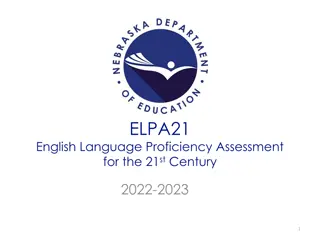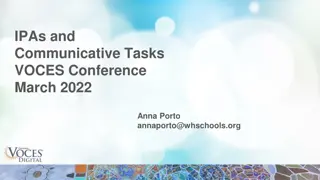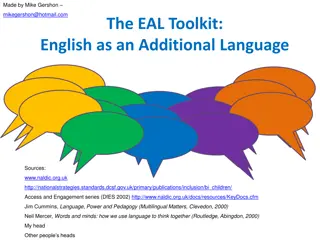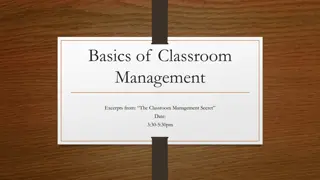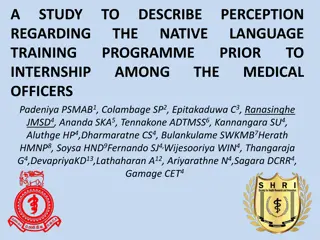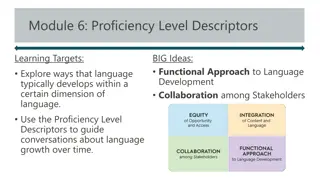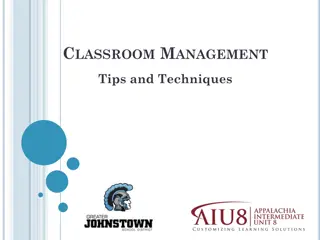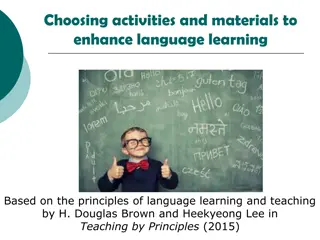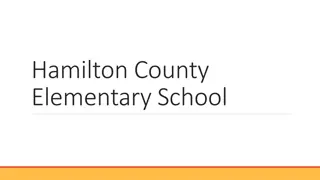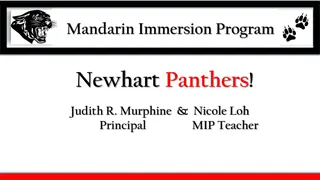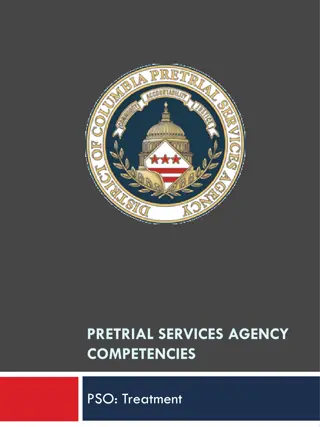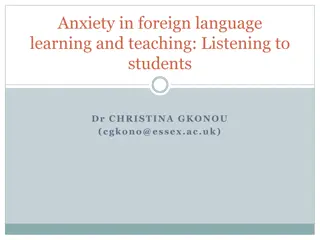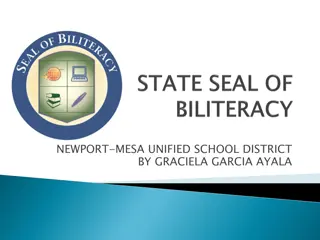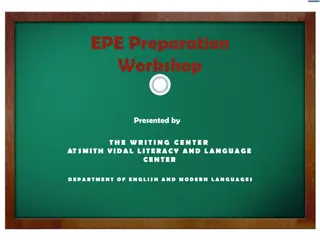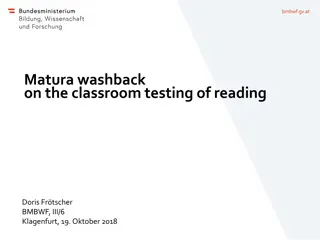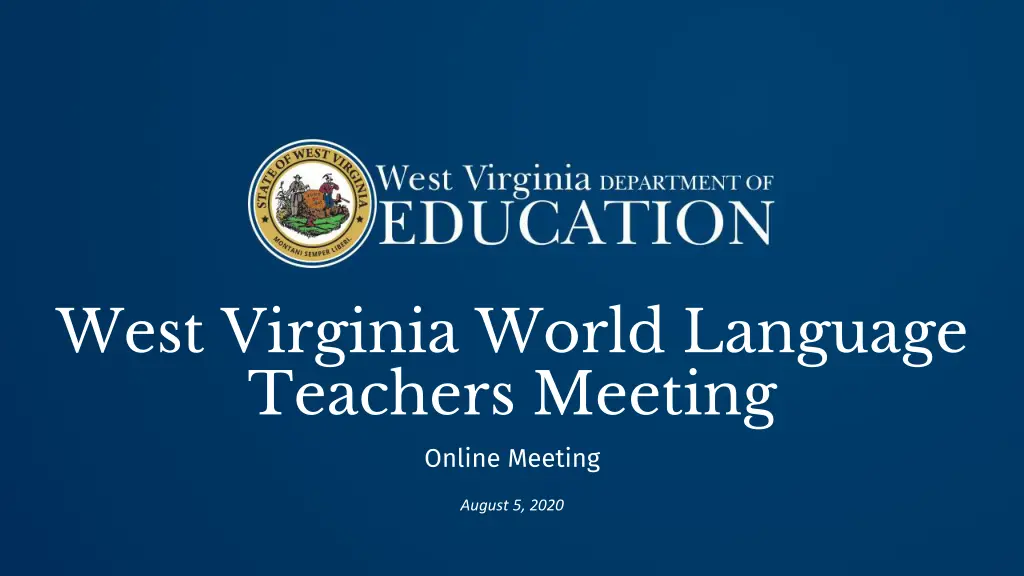
Engaging Strategies for World Language Teachers Meeting Insights
Explore key insights from the West Virginia World Language Teachers Meeting, including priorities, important links, teaching for proficiency, and creating a safe learning environment for students. Gain valuable tips on addressing the achievement gap, promoting social and emotional health, and starting the academic year with a focus on student well-being and language development.
Download Presentation

Please find below an Image/Link to download the presentation.
The content on the website is provided AS IS for your information and personal use only. It may not be sold, licensed, or shared on other websites without obtaining consent from the author. If you encounter any issues during the download, it is possible that the publisher has removed the file from their server.
You are allowed to download the files provided on this website for personal or commercial use, subject to the condition that they are used lawfully. All files are the property of their respective owners.
The content on the website is provided AS IS for your information and personal use only. It may not be sold, licensed, or shared on other websites without obtaining consent from the author.
E N D
Presentation Transcript
West Virginia World Language Teachers Meeting Online Meeting August 5, 2020
AGENDA WVDE Priorities Important Links Starting Back Teaching for Proficiency Gradual Release of Responsibility 2
I can. I can locate WVDE documents which will guide me through the academic year. I can create a safe and risk-free environment for my students. I can identify and create activities that will build language proficiency in my students. I can find ways to be the guide on the side instead of the sage on the stage . 3
PRIORITIES Social, emotional and mental health of our students Equity Achievement gap 4
Important Links http://wvde.state.wv.us/policies/ ( Policy 2520.7) https://wvde.us/covid19/ https://wvk12- my.sharepoint.com/personal/dlnichol_k12_wv_us/_layouts/15/one drive.aspx?id=%2Fsites%2FWorldLanguageTeachers802%2FShared% 20Documents&listurl=https%3A%2F%2Fwvk12%2Esharepoint%2Eco m%2Fsites%2FWorldLanguageTeachers802%2FShared%20Documen ts 5
As You Start Back Plan wisely Consider what really matters Don t be too hard on yourself 6
Achievement Gap/Summer Slide How to catch them up? What is the essential information? What can they teach themselves? Flipped classroom Combine content into thematic units What ideas do you have? 7
Create A Safe Environment Educate students on proficiency levels Respect the right to pass Everyone at a different level No laughing Avoid correcting every mistake Provide appropriate feedback 8
Proficiency Novice Speakers Intermediate Speakers Advanced Speakers Discrete sentences Isolated words and phrases Frequent pauses to search for words Limited vocabulary May be difficult to understand Discrete sentences Ask as well as answer questions related to basic needs Recombine learned language chunks to express their own ideas Generally understood by sympathetic interlocutors Narrate and describe in present, past, and future time frames Connected sentences; paragraph-length speech Handle complications that arise in typical situations Extensive vocabulary Substantial flow of expression 10
Parrot - 0t: a 1 1.1
Moving Students from Novice to Intermediate (Helena Curtain) NOVICE INTERMEDIATE INTERMEDIATE learners communicate in complete, discrete sentences and begin to express their own ideas.. Can create with language, ask and answer simple questions on familiar topics, and handle a simple situation or transaction NOVICE learners are using isolated words and phrases that are memorized and as they move to Novice High they begin to use afew simple sentences Teachers provide sentences starters, sentences frames. They provide graphic organizers for students to organize their thoughts and language. They create word walls to guide students as they add details and descriptions to their spoken and written language. They create language ladders with students and post them They give students opportunities to practice asking questions. They teach them to use conversation strategies: pauses, asking for repetition, agreeing/disagreeing, reacting, asking follow up questions. They provide logs of student-to-student interaction. Curriculum and planning target the next level of proficiency. STARTALK2017
Moving Students from Intermediate to Advanced (Helena Curtain) INTERMEDIATE INTERMEDIATE learners create complete, discrete sentences and begin to express their ownideas ADVANCED ADVANCED learners can narrate and describe in all major time frames and handle a situation complication Teachers assist students in: elaboration techniques, speaking in different time frames, using connectors to move from discrete sentences to paragraphs, reporting events, retelling incidents, creating narratives, dealing with complications that arise in different situations they might encounter in the target culture. with a Curriculum and planning targetthe next level ofproficiency. STARTALK2017
Teaching for Proficiency Target Language Use Pictures Gestures Mime Signaling/Pointing Draw Post common instructions visually Label classroom Safe English space Comprehension checks 14
Teaching for Proficiency Student Accountability Participation grade Clothespin Method One word strategy Pay me Speaking rubric 15
Teaching for Proficiency Teach strategies Circumlocution Paraphrasing Elaboration Student choices Choice boards This or that Open choice 16
Your ideas? 17
I Do Teacher s Role Student s Role Input provider Observe and engage Make input comprehensible Make generalizations to understand Make input interactive Respond to questions Provide context Participate Provide a purpose Check for comprehension 19
We Do Teacher s Role Student s Role Manages output Participate actively Designs activities Work with language chunks in target language Turns input into intake Replicate Models activity Imitates activity Provides a low-risk environment Tries it out with help 20
You Do Together Teacher s Role Student s Role Coach, not help Take over learning task Gives feedback Negotiate meaning Clears up misconceptions or misunderstandings Work actively in pairs or small groups 21
You Do Alone Teacher s Role Student s Role Demonstrates activity Students actively connect and copy the activity 22
CONTINUING EDUCATION CREDITS OR NON-DEGREE CREDIT IS AVAILABLE https://wveis.k12.wv.us/registration/ 23
Instructional Support Professional Learning Forum Session Survey/Evaluation 24

